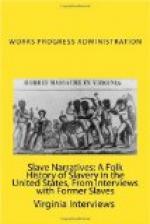One story that the aged man relates is of an encounter with an eagle and follows: “George Irish, a white boy near my own age, was the son of the miller. His father operated a sawmill on Bledsoe Creek near where it empties into the Coumberland river. George and I often went fishing together and had a good dog called Hector. Hector was as good a coon dog as there was to be found in that part of the country. That day we boys climbed up on the mill shed to watch the swans in Bledsoe Creek and we soon noticed a great big fish hawk catching the goslings. It made us mad and we decided to kill the hawk. I went back to the house and got an old flint lock rifle Mars. Mooney had let me carry when we went hunting. When I got back where George was, the big bird was still busy catching goslings. The first shot I fired broke its wing and I decided I would catch it and take it home with me. The bird put up a terrible fight, cutting me with its bill and talons. Hector came running and tried to help me but the bird cut him until his howls brought help from the field. Mr. Jacob Greene was passing along and came to us. He tore me away from the bird but I could not walk and the blood was running from my body in dozens of places. Poor old Hector, was crippled and bleeding for the bird was a big eagle and would have killed both of us if help had not come.” The old negro man still shows signs of his encounter with the eagle. He said it was captured and lived about four months in captivity but its wing never healed. The body of the eagle was stuffed with wheat bran, by Greene Harris, and placed in the court yard in Sumner County. “The Civil War changed things at the Mooney plantation,” said the old man. “Before the War Mr. Mooney never had been cruel to me. I was Mistress Puss’s property and she would never have allowed me to be abused, but some of the other slaves endured the most cruel treatment and were worked nearly to death.”
Uncle Joe’s memory of slavery embraces the whole story of bondage and the helpless position held by strong bodied men and women of a hardy race, overpowered by the narrow ideals of slave owners and cruel overseerers. “When I was a little bitsy child and still lived with Mr. Gardner,” said the old man, “I saw many of the slaves beaten to death. Master Gardner didn’t do any of the whippin’ but every few months he sent to Mississippi for negro rulers to come to the plantation and whip all the negroes that had not obeyed the overseers. A big barrel lay near the barn and that was always the whippin place.” Uncle Joe remembers two or three professional slave whippers and recalls the death of two of the Mississippi whippers. He relates the story as follows: “Mars Gardner had one of the finest black smiths that I ever saw. His arms were strong, his muscles stood out on his breast and shoulders and his legs were never tired. He stood there and shoed horses and repaired tools day after day and there was no work ever made him tired.”




